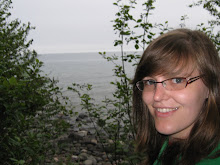These are not original thoughts, unfortunately, but they are worthy of your attention and analysis because...ummmm...because of some theory that would tell you that they're important, but I'm not a communication major so I can't quote it at you...sorry...I don't write CA speeches...my bad...Anyway, just some thoughts I found in my composition handout booky thing....that's not important either...I'm going to stop marring the thoughts with my lack of thought....ugh...whatever...here goes it:
"High up in the North in the land called Svithjod, there stands a rock. It is a hundred miles high and a hundred miles wide. Once every thousand years a little bird comes to this rock to sharpen its beak. When the rock has thus been worn away, then a single day of eternity will have gone by."
"If the world were a village of 1,000 people, it would include:584 Asians, 124 Africans, 95 eastern and western Europeans, 84 Latin Americans, 55 former Soviets, 52 North Americans, 6 Australians and New Zealanders.
The people of the village have considerable difficulty in communicating: 165 speak Mandarin, 86 English, 83 Hindi/Urdu, 64 Spanish, 58 Russian, 37 Arabic. The remaining half of the people speak Bengali, Portuguese, Indonesian, Japanese, German, French, and 200 other languages (in descending order of frequency).
In this village, 329 are Christians (among them 187 Catholics, 84 Protestants, 31 Orthodox), 178 Muslims, 167 "nonreligious", 132 Hindus, 60 Buddhists, 45 atheists, 3 Jews, 86 all other religions.
...
In this village of 1,000 people, 200 people receive 75 percent of the income; another 200 receive 2 percent of the income. Only 70 people of the 1,000 own an automobile (some of those 70 own more than 1).
One third of the people have access to clean, safe drinking water.
Of the 670 adults in the village, half are illiterate.
The village allocates 83 percent of its fertilizer to 40 percent of its cropland - that ownedby the richest and best-fed 270 people. Excess fertilizer running off this land causes pollution in lakes and wells. The remaining 60 percent of the land, with its 17 percent of the fertilizer produces only 28 percent of the food grains but feeds 73 percent of the people. The average grain yield on that land is one-third the harvest achieved by the richer villagers.
...
In the village of 1,000, there are 5 soldiers, 7 teachers, 1 doctor, and 3 refugees.
...
The village has buried beneath it enough explosive power in nuclear weapons to blow itself to smithereens many times over. These weapons are under the control of just 100 of the peole. The other 900 are watching them with deep anxiety, wondering whether they can learn to get along together; and if they do, whether they might set off the weapons anyway through inattention or technical bungling; and if they ever decide to dismantle the weapos, where in the world village will they dispose of teh readioactive materials of which the weapons are made?"
Something to think about, I guess.
Tuesday, February 07, 2006
Subscribe to:
Post Comments (Atom)


No comments:
Post a Comment